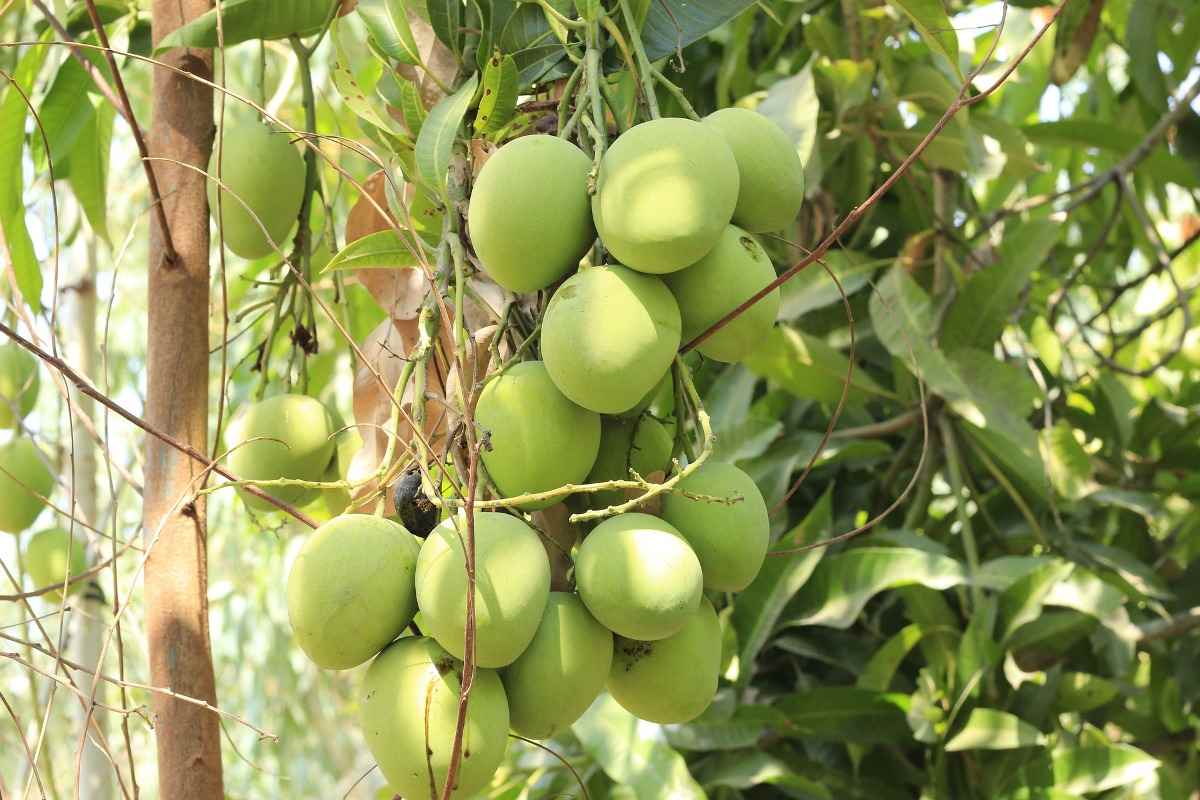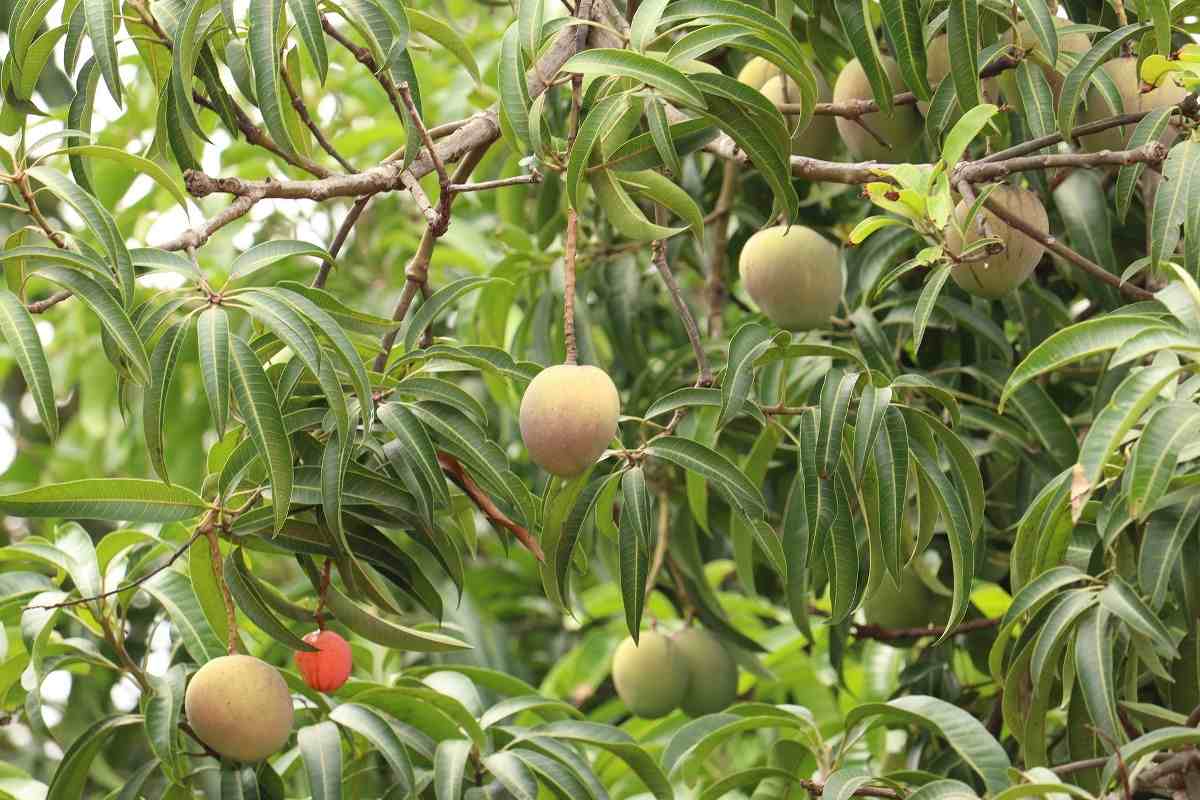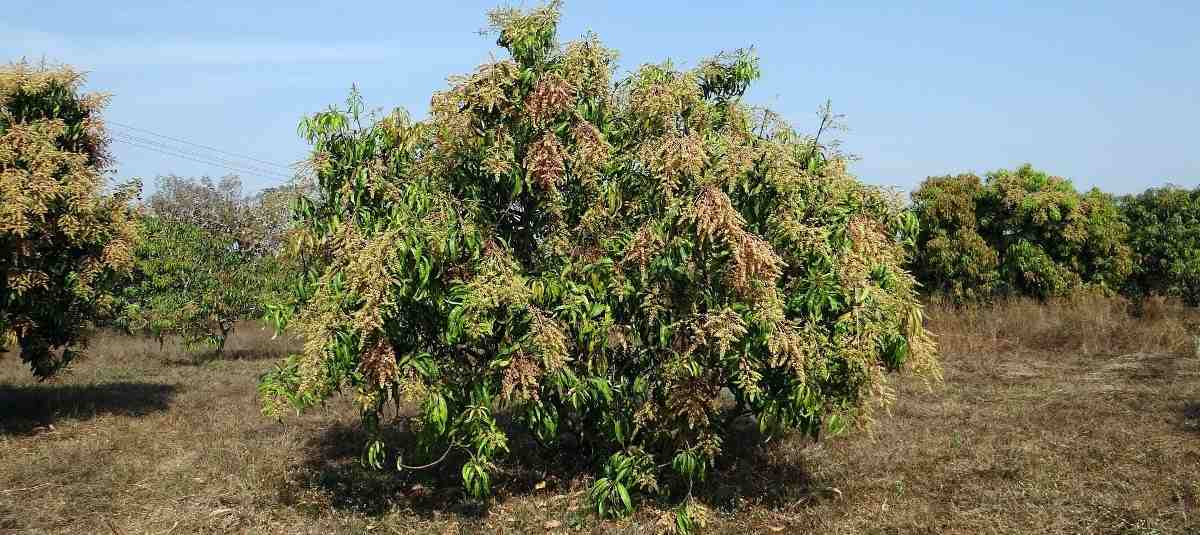Introduction to an organic Mango farming
Mango (Mangifera indica L.) belonging to the Anacardiaceae family is the most important commercially grown fruit crop of the country. Mango is called the king of fruits and India has the richest collection of Mango cultivars. An organic Mango is produced with the use of natural products. An organic Mango is beneficial as compared to a conventional Mango in terms of quality, nutrition, and taste. There are certain health benefits such as prevention of cancer, lowering of cholesterol, clear skin, etc. One of the prominent organic fruits in India is Mango. Several types of Mangoes differ in color, shape, and flavor, and seed size. Mango is a widely consumed fruit all over the world and some types of Mangoes are Kesar, Alphonso, and Dasheri.
A step by step guide to organic Mango farming
Many practices are transferable from a conventional system to an organic system of growing Mango plants. The main changes will be in nutrient, weed, flowering, pest and disease, and postharvest management. No synthetic fertilizers, herbicides, pesticides, and fungicides can be used.

Organic farming is a crop production system that encourages sustainable agriculture by enhancing the biological cycles in nature. It is targeted at producing healthy, high nutritive, pollution-free food maximizing the use of farm resources, and minimizing the use of off-farm resources. And, it seeks to avoid the use of chemical nutrients and pesticides.
Going

Conversion from a conventional system to an organic system is to involve changes to existing management practices and also the adoption of new strategies to meet organic certification. And, changes to management go beyond simply not using synthetic chemicals and fertilizers. Specific methods adopted by individual organic growers will vary according to their circumstances, location of the property, and type of enterprise. Overall management strategies required to reflect the following key organic farming principles;
- Soil health largely determines plant health.
- Organic systems are biological systems.
- Organic farms operate as closed systems as far as possible.
- A holistic approach ensures good integration of management methods.
Many of the best management practices developed for conventional Mango production apply to organic farming systems.
Soil and location for organic Mango farming
Soils preferred for Mango farming are deep loamy, rich in organic matter, with balance content of macro and micronutrient elements. A Mango tree can grow well in all types of soil from alluvial to lateritic, except the black cotton soils, which are considered as poor. The only prerequisite is a deep of about 2 to 2.5 m and well-drained soil. Also, red loamy soil with good drainage is preferred soil for Mango cultivation. Mango prefers slightly acidic soil and it does not grow well beyond a soil pH of 7.5. Saline soil and alkaline soils are not conducive to profitable Mango cultivation.
Selecting a location isolated from potential sources of pest, disease, and weed is desirable; but is not often possible. Sites that are away from conventional Mango production areas, allows relative isolation to reduce the risk of contamination from adjacent land use. If the area is prone to windbreaks, windbreaks are required to protect the Mango crops from wind effects and damage. Selecting better soils is likely to be helpful and need lesser inputs than poor soils. Loamy soils are likely to require fewer nutrient inputs and lower water demands than sandy soil types.
Loamy soils can accommodate organic matter, which in turn is responsible for the development of good soil biological activity suitable for organic Mango production. Chemical or heavy metal residue in soil should not exceed limits set by organic standards. Choosing a small initial block for organic conversion can reduce the commercial risk, as it is unlikely to have a significant impact on crop profit. By starting with a small trial area dedicated to organic methods, growers can gain experience and knowledge about what works and where problems could occur.
Importance of growing Mango organically
- There is a growing market demand for organic Mango fruits.
- For the safety and health of growers and consumers.
- The cost of imported chemical inputs is getting too high.
- Natural organic farming can make farmers self-reliant.
- Organic Mango farming can cost less and environment friendly.
The spacing of Mango trees
Mango tree spacing will determine how many trees will be needed. Spacing will affect yield, growth, and the management practices of an orchard. Spacing between Mango trees changes from variety to variety and a growing environment (dry and wet zone). In the dry zone, the spacing varies from 10 meters x 10 meters (30ftx30ft), as the vegetative growth is limited, while in wet and rich soils the preferred spacing is 12 meters x 12 meters, as of abundant vegetative growth.
In case if you miss this: Organic Banana Farming, Cultivation Practices.

Planting holes must be dug before the onset of a rainy season where possible for water to collect in it to enhance the survival of the seedling planted. The holes must be dug to a depth of 1 meter, the width of 1 meter and length of 1 meter (1m x 1m x 1m). The spacing of these holes must consider the Mango tree canopy as well as the soil fertility of the area.
Kinds of organic fertilizers for Mango farming
- Foliar organic fertilizers derived from a fermented animal of plants such as fish and fruit amino acids.
- Decomposed animal waste mixed with plant residues, plant leaves with beneficial microorganisms.
- Vermicompost and earthworm casting fed with decomposing organic materials. One of the rich forms of organic fertilizer with humic acid, plant-growth-promoting, and beneficial microorganisms.
- Sludge or liquid organic waste materials rich in food nutrients with beneficial microorganisms.
- Green manure is young plant legumes or beans that are plowed under and mixed with the soil during the flowering stage.
- Soil and seed inoculate such as nitrogen-fixing bacteria and microorganisms that help decompose organic materials.
- Use of powdered charcoal, wood ash, and carbonized rice hull.
- Use of natural mineral deposits such as limestone powder, hydrated lime, guano, magnesium oxide, sulfur deposits or spring, ferrous, etc. Plants get their food nutrient from organic and mineral sources. The soil contains a mixture of mineral plant nutrients.
Pruning procedure of Mango trees
Pruning the Mango tree is very important for tree size control and to improve the fruit color. Essentially, tree pruning and canopy management are the same for organic production or conventional production. Tree pruning is done to open up the structure to allow good airflow and adequate internal light. It minimizes disease risk and assists in good fruit coloration. Internal pruning to remove dead wood can be important to help reduce the incidence of diseases like stem-end rot. Rootstock sprouts and low-lying plant branches have to be removed. Overlapping, intercrossing, diseased, dried, weak branches are removed to obtain good sunlight and aeration. For internal branches, pruning can be done during August- September, once in three years. Flowering should not be allowed for up to 3 years.
You may also check this: Organic Hydroponics Farming.
Mango pests and diseases control organically
For organic Mango farming, preventive methods based on proper crop and habitat management are encouraged. And, direct methods of control are reserved for emergencies only. Synthetic insecticides and also fungicides are not allowed in organic Mango production. Successful organic Mango production requires an integrated approach to managing pests and diseases. And, an important part involves underlying preventative strategies that can contribute to minimizing the likelihood and severity of problems. All of the principles of IPM management can be applied to an organic system with the main variation being that substances used for specific pest or disease control may need to be changed.
Mango tree pest control organically
The important pests are hopper, mealybug, stem bores, and fruit fly. A Pest management practice for each pest is described below:
Fruit Fly
Adult and larvae maggots cause Mango fruit damage. Fruit fly attack is controlled by harvesting the Mango crop early when fruits are mature green. This is the stage of maturity when Mango crops are not susceptible to fruit fly attacks. Removal of fruits with dimples, collection, and destruction of fallen and damaged ripe fruits and practicing field sanitation helps in controlling fruit fly pest attacks.
Mango Mealybugs
The mealybug affected leaves are distorted (rolled or folded), stunted, and yellow. Hand-picking of the bugs from the affected Mango plants to reduce populations and pruning the affected plant parts to remove Mango mealy bugs, applying chili, and soap sprays are the suggested control measures. Removal and destruction of heavily infested Mango plant will help in cutting down the infested sites and reducing its future population.
Mango leafhopper
Both the nymphs and adults feed on the plant sap of the flowers, plant leaves, tender shoots, and newly formed fruits. They suck out the liquid contents leaving behind the dead empty cells, which are small white spots. The appearance of sooty mold on Mango plants is an indication of leafhopper infestation. Spraying garlic oil and neem oil are recommended as control measures for this pest.
Mango shoot caterpillar
The larvae feed on the growth flushes of nursery stock, young Mango trees, and top-worked trees. Occasionally, the fruit stalks and young Mango fruits are damaged. It is mainly controlled by applying ginger, garlic, and chilly extract and neem leaf extract. And, pruning the affected parts and burning or burying them helps in controlling their population. The following organic practices for controlling pests in Mango;
- Spraying of Biodynamic pesticide prepared from cow urine, neem, karanj, castor, Thevtia nerrifolia, and Vitex spp.
- Spraying Nettle leaf extract sprays to control hard pests such as Mango hoppers, mealy bugs, etc. Nettle spray is prepared by soaking 250 g of nettle leaf powder in 4-5 liters of water for 24 hours. Filter the extract and mix in 20 liters of cow urine. Dilute to 200 liters in water and spray on foliage to control pests.
Organic disease management in Mango trees
The important diseases of the Mango tree are Powdery mildew, Anthracnose, Stem-end rot, and Sooty mold. Suggested organic measures are as follows;
Powdery mildew
Powdery mildew is a fungal disease caused by Oidium mangiferae and can destroy the crop. Need-based spraying of Horsetail or Casuarina extract helps in controlling the disease.
Anthracnose
Anthracnose is a fungal disease and occurs especially in humid and high rainfall areas. Good canopy management and tree nutrition or soil management, close monitoring, and application of copper hydroxide and potassium bicarbonate sprays help in controlling the disease.
Anthracnose Stem end rot
Removing dead wood, good canopy management, and tree nutrition or soil management helps in controlling the disease. It is reported that the application of calcium to the soil in the form of gypsum at low rates, 2 to 4 kg per tree before flowering reduces the severity of internal fruit disorder significantly. Farmers are applying some commercially available bio-pesticides such as Pseudomonas fluorescens, Verticillium lecanii, Beauveria bassiana as foliar sprays, besides neem oil spray in controlling the disease. Disease management practices are;
- Two sprays of Cow Horn Silica at the flowering and fruit development stage.
- Biodynamic tree paste or cow dung paste for control of gummosis and die back.
- Spraying of Horse tail or Casuarina leaves extracts for control of fungal diseases in the ascending moon period.
- The application of cow dung paste has almost replaced the spray of Copper Oxychloride for the control of die back in rejuvenated old Mango orchards. It is effective in controlling anthracnose and control of stem borer.
Mango fruits harvesting
Mango fruits mature in 3 to 4 months from flowering, fruit color changes from dark green to light green on maturity. Harvesting must be started after few fruits drop, during morning hours. Individual fruits are clipped with 1.5 cm stalk by using Mango harvester. Harvested Mango fruits are kept on gunny bags under shade. Undersized, bruized, and infested fruits are sorted out and healthy Mango fruits are graded into 2 to 3 grades depending upon color, shape, and size and packed in wooden or corrugated boxes.
Post-harvest treatments of Mango
All postharvest operations should comply with organic standards. The main objective is to avoid contamination with prohibited chemicals and to ensure the separation of organic products from any conventional product.
The postharvest procedure adopted is to run organic fruit first after the equipment has had a clean-down. Hazard Analysis Critical Control Points (HACCP) based quality assurance systems are ideal for establishing protocols and audit systems that meet organic requirements. Operations with existing HACCP-based QA systems find that only minor changes are required to comply with organic standards. Packing shed hygiene that involves regular equipment cleaning and removal of reject fruit can reduce the transfer of fungal spores onto new Mango fruit. Fruit destined for domestic markets where storage times are short may not need any post-harvest treatments for fungal control. Longer-term storage and fruit for export are likely to require some form of treatment to reduce Mango fruit breakdown from the diseases anthracnose or stem-end rot.
In case if you are interested in How to Make Money from Organic Farming Business.
i have a 5 acres farm near pune on mulshi lake.
-where can i find a list of native fruits / vegatables suitable for this particular geographic location?
-what are the native cow breeds of this area and where one get them?
thanks for your help.
Can you suggest where we get mango plants?
You can try nurseries in Sanga Reddy near Hyderabad for a Variety of Mango Plants.
Please advise me where I can find good AMARPALI mango plants?
Is there any particular time to plant mango trees?
I am growing Mangoes using natural farming techniques. Where can I find the buyers of organic mangoes. I recently got APEDA scoped certificate. My farm is based in Puttaparthi, Anantapur district.
I have Mango orchards in Sherkot a small town in the DIst -BIjnor of UP. i want to make it organic but don’t know how viable is it commercially, i need proper handholding and scientific research techniques to convert my orchards into fully organic mango orchards. As i am also planning to export my mango to other countries. For that what licenses are required and how i will meet the requirements of those licenses. Please guide me
Hi i have 5 acres of land i want do organic farming ..
I want to plant mango trees n export them can u plz help me to where can i find good trees n organic methods of growing trees……